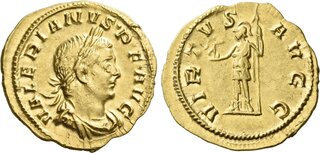| Numismatica Ars Classica > Auction 146 | Auction date: 8 May 2024 |
| Lot number: 2379 Price realized: This lot is for sale in an upcoming auction - Bid on this lot  | Show similar lots on CoinArchives Find similar lots in upcoming auctions on |
| Lot description: Valerian I, 253 – 260. Aureus, Colonia Agrippinensis circa 257-260, AV 17 mm, 1.89 g. VALERIANVS P F AVG Laureate, draped and cuirassed bust r. Rev. VIRTVS – AVGG Virtus standing l., holding Victory and spear. C –. RIC –. Göbl 887b. Calicó –. Of the highest rarity, only one specimen listed by Göbl, and in exceptional condition for the issue. Virtually as struck and almost Fdc Ex Stack's & Ponterio sale 14 August 2019, 20098. Publius Licinius Valerianus was born around 190 AD into a wealthy senatorial family. He showed considerable talent as a politician and served as consul during the reign of Severus Alexander. During the years 238-250 AD, he held a series of important civilian and military posts as the Roman Empire plunged into an era of civil war, invasion, pestilence, and economic collapse. In AD 253, he was commander of the Rhine garrison when he and his army were summoned to Rome by the embattled emperor Trebonianus Gallus to defend his regime against the usurper Aemilian. While Valerian was en route, Gallus was murdered by his own troops and Aemilian seized the throne. In a pattern typical of the age, Valerian's troops proclaimed him emperor and he, in turn, marched against Aemilian, who suffered the same fate as Gallus. Valerian's elevation was quickly approved by the Senate. He appointed his son Gallienus as co-ruler and sent him to defend the crumbling Rhine frontier while Valerian focused on a deepening crisis in the east. The Goths had commandeered some Roman ships and were plundering Asia Minor at will while, at the same time, Shapur I, king of resurgent Sasanian Persia, had crossed the eastern frontier and sacked Antioch. After taking stern measures against those he considered subversives, including Christians (against whom he mounted a major persecution), Valerian mustered a large legionary force and marched east in AD 255. After forcing the Goths to retreat, he spent the next four years campaigning in the Syrian desert in a fruitless effort to force Shapur into a decisive battle. In 260 AD, with his army weakened by pestilence and exhaustion, Valerian agreed to a peace parlay with Shapur. But on his approach, he and his bodyguards were seized and taken prisoner by Shapur. This was an unprecedented calamity and marked the Empire's darkest hour. Gallienus was unwilling or unable to come to his rescue, and Valerian remained in ignominious captivity for many years, where he endured such humiliations as being forced to serve as Shapur's footstool. After his death, Valerian's skin was flayed and stuffed, the effigy being presented to later Roman envoys as an object lesson. Estimate: 25000 CHF |  |



